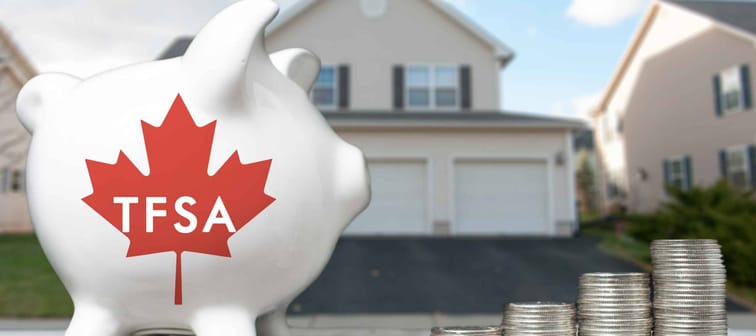What is a TFSA?
You probably already have a savings account, where you squirrel away extra cash. Why do you need another one?
To be honest, the term "Tax Free Savings Account" is somewhat misleading. A TFSA is so much more than just a place to store your cash. Think of your TFSA, not merely as a bank account, but rather as a versatile container in which you can fund a variety of investments, such as stocks, bonds and guaranteed investment certificates (GICs).The money you contribute within your TFSA will accrue interest, just like it would with a regular savings account. However, everything you gain will be exempt from taxation, even when you go to withdraw it. That includes any dividends or gains on your investments.
Sounds great, right?
A few exceptions will be taxable, like dividends on foreign investments. And one big caveat is that you should never use your TFSA for day trading. If you do so many transactions in your TFSA that you start looking like a business, the Canada Revenue Agency could club you with a 50% tax on all those earnings.
A better online investing experience
Easy to use and powerful, Qtrade's online trading platform puts you in full control with tools and resources that help you make well-informed decisions.
Invest NowDo you get taxed on a TFSA?
The good news is that you generally don’t have to pay any taxes on your tax free savings account Canada earnings. This includes interest, dividends and capital gains, which remain tax-free both while held in the account and upon withdrawal.
However, there are always exceptions. For example, contributions made while the account holder is determined to be a non-resident of Canada are subject to a penalty tax of 1% per month on the contributed amount. If you exceed the TFSA contribution limit, you’ll face a penalty tax of 1% per month on the excess amount until it's withdrawn or additional contribution room becomes available.
What are the Tax Free Savings Account limits?

The beauty of a TFSA is that there’s no minimum investment as long as you stay within your yearly and overall investment limits. You can put in $5; you can put in $5,000. You can even set up an automated payment schedule, taking a few bucks off every paycheque.
While you may be tempted to dump all your money into TFSAs, the Government of Canada limits how much you can contribute each year. The current limit for 2024 is $7,000. Note that that total is not for EACH account, rather it is the max you can contribute overall in one year into your TFSA accounts. Any gains or interest you earn in a TFSA don’t count against this contribution room.
If you do have over $7,000 to invest, you’ll have to do so outside of your TFSA (unless you still have contribution room from previous years that you can use up). If you don’t have any contribution room remaining, consider opening a non-TFSA automated investment account. An example is Wealthsimple, which will automatically adjust your portfolio to give you some protection from market turbulence.
Make sure you don’t get carried away with your TFSA. Contributions over the $7,000 limit will be dinged a 1% penalty per month on the excess until that money is withdrawn.
But here’s where it gets fun: If you don’t make the full $7,000 contribution to your TFSA in a given calendar year, your unused contribution limit rolls over to the next year. And it will continue rolling over, expanding your contribution limit year after year.
So if you’re low on cash now but come into a windfall down the line, you’ll be able to make up for lost time.
And if you’ve never had a tax free savings account in Canada before, you might have a colossal amount of room built up by now, to the tune of $95,000 in 2024.
Unexpected vet bills don’t have to break the bank
Life with pets is unpredictable, but there are ways to prepare for the unexpected.
Fetch Insurance offers coverage for treatment of accidents, illnesses, prescriptions drugs, emergency care and more.
Plus, their optional wellness plan covers things like routine vet trips, grooming and training costs, if you want to give your pet the all-star treatment while you protect your bank account.
Get A QuoteWhen can I withdraw money from my TFSA?

What draws most people to a TFSA over an RRSP or other savings vehicle is that your money can easily be freed up in case of an emergency — or if you’re just saving for a round-the-world vacation or other big purchase.
You can move money from your TFSA into a chequing account at any time, for any reason and without penalty. Just keep in mind that some banks, like RBC, implement a 24-hour waiting period before you can actually access the money.
Note that any money you take out cannot be returned in the same year, if you had already reached your yearly maximum contribution. If you topped up your contribution in January, moved $600 out in June and put it back in by August, that’s considered a new contribution and $600 comes off your yearly contribution limit. You’ll have to wait a year to get that contribution room back, so be mindful.
What happens to my TFSA if I leave the country?

If you’re planning on moving abroad for a long period of time (extended vacations do not count), you can simply withdraw all of your money from your TFSA without any tax penalty.
If you want to keep your TFSA open, things get a little trickier. You can still keep your TFSA open as a non-resident, but you cannot make any contributions. Any contributions made as a non-resident will be subject to the same tax penalty as an over-contribution: 1% per month, for as long as the money remains in the account.
Can I write off my TFSA contributions?

No, your TFSA contributions are not tax deductible. That includes any administrative fees, interest or money borrowed to contribute to an account.
With a TFSA, your contributions were already subject to tax before going in, so they’ll be tax-free when you go to withdraw them.
What is the downside of a TFSA account?
There are a few key downsides and potential traps to be aware of with TFSAs:
- Contributions to your TFSA do not count as tax deductions, so any money put into a TFSA has already been taxed, unlike RRSP contributions which are tax deductible (though you also don’t have to pay withholding taxes when you take out money from a TFSA)
- Overcontributions lead to penalties: If you exceed your TFSA contribution limit, the government imposes a 1% per month penalty on the excess amount until it is withdrawn or additional contribution room becomes available, so be sure to track your money if you have multiple TFSA account
- You can’t replace a withdrawal in the same year if you’ve maxed out your contribution room
Is it worth putting money in a TFSA?
TFSAs are an amazing way to grow your money, tax free. It’s incredibly rare to have an account where you won't pay taxes on any interest, dividends or capital gains earned within the account. So take advantage! While contributions don’t lower your income and thus help reduce your yearly income tax owing as RRSPs do, with TFSAs you don’t ever have to feel your money is locked in or worry about paying huge withholding taxes. TFSAs are ideal for various savings goals, from short-term big purchases to long-term wealth building and retirement savings.
How do I get a TFSA?

Finding a local advisor is easier than you think. They will support by listening to your financial goals and help you build a plan to maximize your TFSA.
Setting up a TFSA is one of the easiest steps you can take toward building a more financially secure future. It’s an especially good tool for young people getting started with their savings, because it provides the tax-sheltered status of an RRSP but with the flexibility to make withdrawals for all the big purchases still to come.
So go ahead — invest in you.
With files from Sandra MacGregor
Sponsored
Trade Smarter, Today
Build your own investment portfolio with the CIBC Investor's Edge online and mobile trading platform and enjoy low commissions. Get up to $100 in commission-free options until October 31, 2024.







